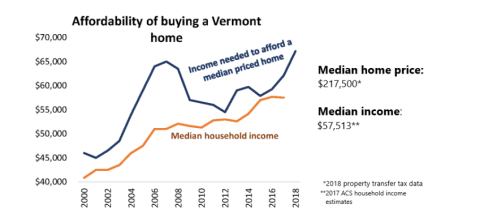Vermont home prices reached new highs in 2018, continuing a four year trend of growth. However, household incomes have not kept pace, making it increasingly difficult for low and middle-income Vermonters to become homeowners.

According to data from Vermont Property Transfer Tax records, the median price of a primary home in Vermont increased 3.6%, from $210,000 in 2017 to $217,500 in 2018. Prices increased more rapidly in fast-growing areas of the state like Chittenden County, which saw a 5% increase in home prices from last year. The number of homes sold in Vermont picked up slightly from 2017, to the highest level since the recession, but overall volume remains 35% lower than the peak year pre-recession. A low inventory of homes tends to increase competition among homebuyers, driving up prices.
At the same time home prices have increased, wages for most Vermonters have remained stagnant for years, according to the Public Assets Institute. To be able to afford the 2018 median home price of $217,500, a household would need to earn at least $68,635. However, the median household income for Vermonters is just $57,513, according to 2017 Census Bureau estimates. A lack of affordable housing may prevent employers from attracting skilled workers, hindering economic growth.
The imbalance between incomes and prices can make it difficult to purchase a home, particular for first-time buyers. Fortunately, Vermont Housing Finance Agency’s homeownership programs can help young households afford their first home. VHFA’s ASSIST program offers up to $5,000 in down payment assistance, which can often be one of the most significant obstacles to homeownership.
